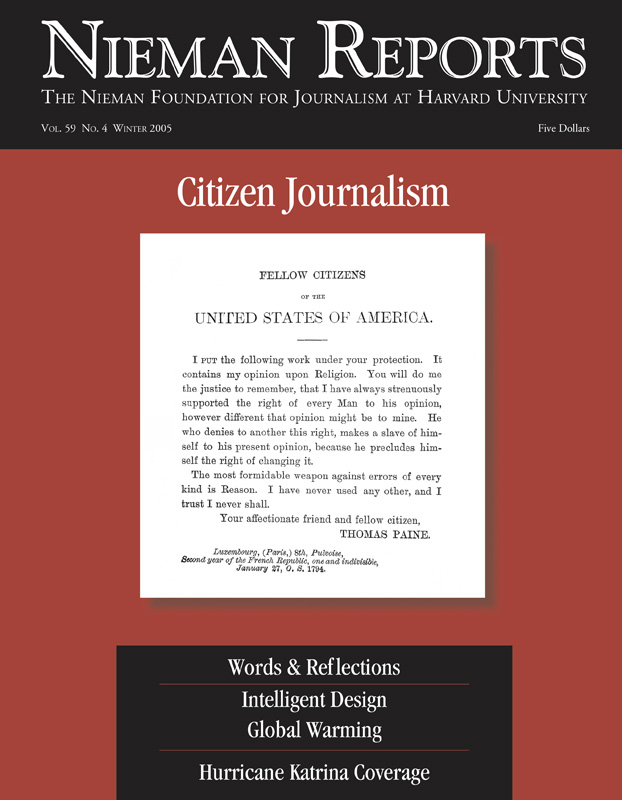One Sunday in August 2004, as I set down The New York Times Book Review, it suddenly occurred to me that there was sufficient evidence to explore one of the biggest stories of our time in a new way. I’d just read Al Gore’s review of Ross Gelbspan’s “Boiling Point,” and that review, coupled with other readings I’d done on climate change, suggested that the signs of global warming were now sufficient to consider the story in human terms. Yet most of the reporting in the U.S. press remained focused on the debate over whether the planet is warming and, if it is, whether human activity could be partly to blame. With scientists largely in agreement on these questions (resoundingly in the affirmative), and early signs of warming coming in from the Arctic and elsewhere, it seemed possible that a team of reporters could begin documenting the social, cultural, political and economic impact of climate change around the world.
I approached colleagues at the Graduate School of Journalism at the University of California-Berkeley, where I teach international reporting and, after several encouraging conversations, including with Dean Orville Schell and the environmental and science writer Michael Pollan, I began to investigate whether these early signs were sufficient for a full-scale investigation by a team of the school’s reporters.
On September 1, 2005, 12 journalists gathered for our first class, charged with finding stories in which global warming would be explored not only through the lens of science and environment but also in human terms. How is a warming planet starting to affect people and the lives they lead? I designed “Early Signs: How Global Warming Affects Commerce, Culture and Community,” as a two-semester seminar and reporting workshop. Our task was to combine intensive study of the science, politics, economics and social impacts with active story development in regions as far flung as the sub-Arctic, South America, Africa, the Indian subcontinent, and the South Pacific.
A central premise of the class was based on the scientific consensus that human activity is contributing to global warming. We intended to avoid the pitfall of creating a false balance of “dueling experts” that gives equal weight to unequal sides. This did not mean that we wouldn’t learn all sides of an argument but that in our pursuit of knowledge and story ideas (which would involve several hundred pages of reading each week in the first two months), we’d place such skepticism in scientific and political context.
Accepting that global warming exists and that humans are part of the engine driving it did not, of course, mean that we’d abandon the rigor or skepticism that reporters always apply. Indeed, as my reporters began to research stories in Australia, the Azores, Bangladesh, Canada, Cuba, Ecuador, India, Mali, Peru, Portugal, New Zealand, Tanzania, Tibet, Zambia and the Pacific Islands, they were required to vet the science through a formal review process overseen by my colleague John Harte, a global warming expert at the University of California’s Energy and Resources Group, who serves as my co-instructor and the science advisor to our team.
Through Harte’s review and reporters’ conversations with other experts in the field, we decided not to move ahead with stories on agriculture in Argentina, potential threats to the Azores, farming in Zambia, and drought in Australia. We also decided not to focus on Hurricanes Katrina and Rita for a number of reasons. These included the timing of our work, the heavy news coverage from other outlets and, as Harte pointed out, even though the science strongly suggests that warming oceans will generate more powerful hurricanes, it is difficult to point to any specific storm and connect it with global warming.
Harte explained to students that each successful story proposal would likely fall into one of three categories. One type would document the result of changes due to melting ice, rising sea levels, or elevated sea surface temperatures, which science has clearly linked to global warming. Another kind would focus on political or economic impacts, such as a South Pacific refugee program for displaced islanders or planning for sea level rise in vulnerable delta areas like Bangladesh. A third category was more challenging. In situations in which changes from a warming planet were more subtle or indirect, the story proposal would need to show scientific evidence that the situation was “clearly not the result of a long sequence of fluctuations that are part of natural variability.” Thus, stories about powerful storms or droughts carried a higher burden of proof, and reporters had to cite peer-reviewed science explicitly linking such stories to global warming. Ultimately, each story had to be stamped with Harte’s approval.
As Harte and I signed off on the students’ proposals, the reporters worked up extensive story memos to show us their ability to transform their ideas into compelling narratives, populated with real people and a sense of place. Simultaneously, I contacted former colleagues at National Public Radio’s environmental newsmagazine show, “Living on Earth,” and at U.S. daily newspapers, in an effort to place our large body of work. (We are still looking for a newspaper home for our series.)
In late October, with funds from the Graduate School of Journalism, our Arctic team of Jon Mooallem and Nick Miroff flew to the upper Hudson Bay to document how a small Canadian town is being transformed by melting ice and the changed terrain for polar bears. Many of the other reporters would do their travel during the university’s holiday break: Jori Lewis and Kate Cheney Davidson will go to the snows and inland lakes of Tanzania; Aaron Selverston to the Pacific Island nation of Kiribati; Pauline Bartolone and Felicia Mello to South America’s glacial highlands and its Amazon; Durrell Dawson and Alexandra Berzon to New Zealand, and Sandhya Somashekhar and Emilie Raguso to Bangladesh.
During the spring semester, they will transform their reporting into stories.


